#mass study model
Explore tagged Tumblr posts
Text
Ok, still a lot a work to do butttttttttt, I'm really liking how it's coming out! Some pieces are missing but I will get there.

#art#drawing#draw#painttoolsai#digital art#art digital#illustration artists#studies#ilustration#face mask#mass effect helmets#mass effect 2#mask#mass effect shepard#mass effect#mass effect fanart#mass effect 3#mass effect helmet#female shepard#3d model#3d art#3d render#3d#blender 3d
3 notes
·
View notes
Text
I want to tell a story to the artists and would-be artists out there.
When I was 19, I made a large oil painting of the nerd I would eventually marry. I poured all my attention and care into this painting. It's the only art I have from back then that still holds up as a work I'm proud of today.
I entered it into a judged show at the local art center. It got an honorable mention. I went to see the show with my beloved model. One of the judges came up to talk to me, and highlighted that all the judges really liked the painting. It would have placed, except, you see, the feet were incorrect. They were too wide and short, and if I just studied a bit more anatomy-
I called over my future wife, and asked her to take off her shoe. Being already very used to humoring me, she did. The judge looked at her very short, very wide little foot. Exactly as I'd lovingly rendered it. I would never edit her appearance in any way.
The judge looked me in the eye, and to his credit, he really looked like he meant it when he said "Oh I'm so sorry."
Anyways the moral of the story is that all of those anatomy books that teach you proportions are either showing you averages, or a very specific idea of an idealized body. Actual bodies are much more varied than that.
So don't forget to draw from observation, and remember that humans aren't mass produced mannequins. Delight in our variation. Because it's supposed to be there.
125K notes
·
View notes
Text
Statistics- Again
men constitute 97% of (non fatal) strangulation attacks
men constitute 99% of acid attacks
men constitute 99.99% of child pornography
men constitute 98% of mass shootings
men constitute 99.8% of rapists
men constitute 86% of homicides
men constitute 95% of forcible incest
men constitute 99.99% of child sex abuse
men constitute 99% of molesting cases
men constitute 96% of domestic violence/abuse
men constitute 99% of drugging
men constitute 90% of stalking
men constitute 99.99% of human trafficking perpetrators
men constitute 99% of sex trafficking abuse
Men constitute 99% of animal abuse
Men constitute 98% of bestiality
_________________________Original Post_________________________
92.6% of makeup companies are male
97% of all creative directors are male
98% of modeling agencies are male
92% of fashion media is male
96% of the fashion industry is male
___________________________Rape_________________________
Women are 21x more likely to get raped, yet this is seriously underreported considering the dead bodies
1/3 of all women internationally report being sexually assaulted. we know this number to be much higher due to autopsies reported in the census
Women are 400,000,000x more likely to DIE from RAPE than a man
not one man has ever died from rape, accounts for no coroner report ever, whereas tens of thousands of women and children die a year.
i tried to find a statistic refuting this but i could not
________________________Sex Trafficking________________________
50 million women are sex trafficking victims
women make up for 95% of labor trafficking
70% of child labor is FEMALE
25 million women are forced into child marriages
650 million girls are in arranged marriages/ marriages consummated below the age of consent
_________________________Fetish / Kink_________________________
Men make up most 98% on average of every fetish community
Men make up 99% of pedophilia.
10% of men are pedophiles
_________________________International_________________________
in 70 countries - that comprise 26% of the world population, women need men's permission to learn, work, or travel.
There are 50 countries in which the law states you can sell and buy women into marriage. - These countries, including India and Pakistan, make up 38% of the entire world.
There are 178 countries that do not have the same legal rights for women, where written law specifically excludes women from freedom.
There are 2.4 billion women globally who are born in countries that have written law that restricts them completely, but even more so without a man.
6 billion people believe in a religion that states that women are less human than men
_________________________Original Post_________________________
Infographic Sources
_________________________More Studies_________________________
Study on objectification
Study on empathy
Some Fashion Industry Stats & Sources
Infographic
#radblr#radical feminist community#radical feminist safe#radical feminists do interact#terfblr#radical feminism#radical feminist theory#gender critical feminism#terfsafe#feminist#gnc#gnc women#gnc lesbian#gender nonconforming#gender identity#gender cult#gender ideology#gendercrit#gender critical#gender criticism#feminism#radical feminists do touch
1K notes
·
View notes
Text

STUDY MODEL
Harvard Core Studio - instagram post - https://www.instagram.com/gsdcore3/
_ik
0 notes
Note
do you have any silco x reader fic recs? both on ao3 and tumblr?
Oh boy do I.
I have zero time for reading these days (sob sob) so I'm sadly not at all familiar with any new fics post S2 being aired. But let me lay before you a sumptuous feast; lovingly prepared by the old guard of the Silco fucker society.
Reader's responsibility applies - please check tags etc etc..
Flawless - @a-gal-with-taste
An apt title, for Gal's writing is, indeed, flawless. Silco x Sex Worker!Reader. Absolutely brutal and beautiful - to me, Gal is the Angela Carter of the Silco fandom.
Here be Dragons // Hic Sunt Dracones - @sherwood-forests
This will always be one of my top recommends for a Silco x Reader fic. It's unlike anything else that I've seen in the fandom, and it reminds me of one of my favourite books Uprooted by Naomi Novik. Gives me the cosy feels.
Penance - @astudyincontrasts
Hands down the hottest, sexiest Silco fic in my opinion. If you enjoyed Fleabag or want to bang that priest from Midnight Mass then you need to get on this fic ASAP. To this day I cannot set foot in a church without getting horny. Thanks Study.
Secret Ingredient - @sweatandwoe
This is the Silco fic that made me want to write my own. DWM exists because of Sweaty. Domestic romance and drama of the absolute best kind.
Come Morning - @chickenparm
Parm has so many Silco fics and they are all incredible and required reading for the fandom. But I've chosen this one because it's so incredibly real and human, and will rip your heart to shreds.
Swapped - @silcoitus
I love seeing my blorbos in Situations™ and this is one hell of a Situation™ to find oneself in. Fun, funny, and full of tension. I get the pleasure of beta-reading this one, and I always have the best time squawking at Coi in the comments bar on google docs.
Go, Team! - @vasiktomis
This is actually Marcus x Reader x Silco and it's fucking genius. Vas is a genius and a pervert and I love them and they're my role model. Everyone absolutely has the right not to engage with content that they're not interested in but also if you don't read this fic then you're a coward.
Bend But Not Break - @constantfragmentation
This is a Jane Eyre retelling in the form of a Silco x Reader fic. Yeah that's right. Regency Silco. Emotional constipation cranked up to the max and coats with tails? Yes please. Ensure that you're near a fainting couch whilst reading because you will swoon.
Art in the Heart - @juniper-sunny
Juni was out here giving Young Revolutionary Silco his time in the spotlight long before he was ever animated. If you're a new to the fandom and have come here specifically because of young Silco then AITH is required reading. Head over to Juni's you'll be fed good.
To The Depths - @cognacandlilac
Full disclosure, I haven't actually had the chance to read this fic yet. But it has been on my TBR for an embarrassingly long time and every time I see a snippet I'm like "hot damn I need to get on this pronto" because I just know I'm going to be totally obsessed and consumed by it.
I've only picked one fic for each of the above but I would honestly recommend just tearing through the entirety of their fic lists because there are some absolute masterpieces in there. This is also far from an extensive list - there are so many incredible writers in the fandom and I'm so sorry for anyone I've missed off. I say this with my whole heart - the Silco fandom is easily one of the most talented and skilled corners of the internet. We may be fairly small in numbers compared to other characters/fandoms, but by God the art and stories we have are platinum quality.
794 notes
·
View notes
Text

A simulated image of NASA’s Nancy Grace Roman Space Telescope’s future observations toward the center of our galaxy, spanning less than 1 percent of the total area of Roman’s Galactic Bulge Time-Domain Survey. The simulated stars were drawn from the Besançon Galactic Model.
Exploring the Changing Universe with the Roman Space Telescope
The view from your backyard might paint the universe as an unchanging realm, where only twinkling stars and nearby objects, like satellites and meteors, stray from the apparent constancy. But stargazing through NASA’s upcoming Nancy Grace Roman Space Telescope will offer a front row seat to a dazzling display of cosmic fireworks sparkling across the sky.
Roman will view extremely faint infrared light, which has longer wavelengths than our eyes can see. Two of the mission’s core observing programs will monitor specific patches of the sky. Stitching the results together like stop-motion animation will create movies that reveal changing objects and fleeting events that would otherwise be hidden from our view.
youtube
Watch this video to learn about time-domain astronomy and how time will be a key element in NASA’s Nancy Grace Roman Space Telescope’s galactic bulge survey. Credit: NASA’s Goddard Space Flight Center
This type of science, called time-domain astronomy, is difficult for telescopes that have smaller views of space. Roman’s large field of view will help us see huge swaths of the universe. Instead of always looking at specific things and events astronomers have already identified, Roman will be able to repeatedly observe large areas of the sky to catch phenomena scientists can't predict. Then astronomers can find things no one knew were there!
One of Roman’s main surveys, the Galactic Bulge Time-Domain Survey, will monitor hundreds of millions of stars toward the center of our Milky Way galaxy. Astronomers will see many of the stars appear to flash or flicker over time.
youtube
This animation illustrates the concept of gravitational microlensing. When one star in the sky appears to pass nearly in front of another, the light rays of the background source star are bent due to the warped space-time around the foreground star. The closer star is then a virtual magnifying glass, amplifying the brightness of the background source star, so we refer to the foreground star as the lens star. If the lens star harbors a planetary system, then those planets can also act as lenses, each one producing a short change in the brightness of the source. Thus, we discover the presence of each exoplanet, and measure its mass and how far it is from its star. Credit: NASA's Goddard Space Flight Center Conceptual Image Lab
That can happen when something like a star or planet moves in front of a background star from our point of view. Because anything with mass warps the fabric of space-time, light from the distant star bends around the nearer object as it passes by. That makes the nearer object act as a natural magnifying glass, creating a temporary spike in the brightness of the background star’s light. That signal lets astronomers know there’s an intervening object, even if they can’t see it directly.

This artist’s concept shows the region of the Milky Way NASA’s Nancy Grace Roman Space Telescope’s Galactic Bulge Time-Domain Survey will cover – relatively uncharted territory when it comes to planet-finding. That’s important because the way planets form and evolve may be different depending on where in the galaxy they’re located. Our solar system is situated near the outskirts of the Milky Way, about halfway out on one of the galaxy’s spiral arms. A recent Kepler Space Telescope study showed that stars on the fringes of the Milky Way possess fewer of the most common planet types that have been detected so far. Roman will search in the opposite direction, toward the center of the galaxy, and could find differences in that galactic neighborhood, too.
Using this method, called microlensing, Roman will likely set a new record for the farthest-known exoplanet. That would offer a glimpse of a different galactic neighborhood that could be home to worlds quite unlike the more than 5,500 that are currently known. Roman’s microlensing observations will also find starless planets, black holes, neutron stars, and more!
youtube
This animation shows a planet crossing in front of, or transiting, its host star and the corresponding light curve astronomers would see. Using this technique, scientists anticipate NASA’s Nancy Grace Roman Space Telescope could find 100,000 new worlds. Credit: NASA’s Goddard Space Flight Center/Chris Smith (USRA/GESTAR)
Stars Roman sees may also appear to flicker when a planet crosses in front of, or transits, its host star as it orbits. Roman could find 100,000 planets this way! Small icy objects that haunt the outskirts of our own solar system, known as Kuiper belt objects, may occasionally pass in front of faraway stars Roman sees, too. Astronomers will be able to see how much water the Kuiper belt objects have because the ice absorbs specific wavelengths of infrared light, providing a “fingerprint” of its presence. This will give us a window into our solar system’s early days.

This animation visualizes a type Ia supernova.
Roman’s High Latitude Time-Domain Survey will look beyond our galaxy to hunt for type Ia supernovas. These exploding stars originate from some binary star systems that contain at least one white dwarf – the small, hot core remnant of a Sun-like star. In some cases, the dwarf may siphon material from its companion. This triggers a runaway reaction that ultimately detonates the thief once it reaches a specific point where it has gained so much mass that it becomes unstable.
youtube
NASA’s upcoming Nancy Grace Roman Space Telescope will see thousands of exploding stars called supernovae across vast stretches of time and space. Using these observations, astronomers aim to shine a light on several cosmic mysteries, providing a window onto the universe’s distant past. Credit: NASA’s Goddard Space Flight Center
Since these rare explosions each peak at a similar, known intrinsic brightness, astronomers can use them to determine how far away they are by simply measuring how bright they appear. Astronomers will use Roman to study the light of these supernovas to find out how quickly they appear to be moving away from us.
By comparing how fast they’re receding at different distances, scientists can trace cosmic expansion over time. This will help us understand whether and how dark energy – the unexplained pressure thought to speed up the universe’s expansion – has changed throughout the history of the universe.

NASA’s Nancy Grace Roman Space Telescope will survey the same areas of the sky every few days. Researchers will mine this data to identify kilonovas – explosions that happen when two neutron stars or a neutron star and a black hole collide and merge. When these collisions happen, a fraction of the resulting debris is ejected as jets, which move near the speed of light. The remaining debris produces hot, glowing, neutron-rich clouds that forge heavy elements, like gold and platinum. Roman’s extensive data will help astronomers better identify how often these events occur, how much energy they give off, and how near or far they are.
And since this survey will repeatedly observe the same large vista of space, scientists will also see sporadic events like neutron stars colliding and stars being swept into black holes. Roman could even find new types of objects and events that astronomers have never seen before!
Learn more about the exciting science Roman will investigate on X and Facebook.
Make sure to follow us on Tumblr for your regular dose of space!
#NASA#astronomy#telescope#Roman Space Telescope#dark energy#galaxies#cosmology#astrophysics#stars#galaxy#space images#time#supernova#Nancy Grace Roman#black holes#neutron stars#kilonova#rogue planets#exoplanets#space#science#tech#technology#Youtube
3K notes
·
View notes
Text
doesn't take a genius

you're stuck in a time loop and the only thing that keeps changing is ratio and his actions....3.1k w.count

a/n: full disclaimer, this is entirely based on a dream i had about ratio soooo i'm pretty much 103% certain this may end up feeling a bit ooc for our silly yet stoic dr. that and i have NOT sat down to do a good character study for him hnng ;n; regardless, i had to try and put it into words bc the images in my head wouldn't let me rest until i did orz
[no warnings to mention! just fluff (●'◡'●) also g.neutral reader!]

You sit outside the museum on a nearby bench. There's a crowd of people holding excitedly onto brochures, leaflets, and flyers all broadcasting the newly opening exhibition featuring a full model replica of a certain doctor-professor combo you know- although about 3 times his actual size.
Despite the buzzing atmosphere of excitement- with a touch of giddy from those who find said scholar a nice piece of eye candy- you did not feel the same. Not anymore- anyway.
Sitting with your back hunched over so your elbows rest on your legs, your hands cup your cheeks, and you stare out into the road of passing cars and pedestrians alike- all of which you recognize.
Although this section of the museum is brand-new, and ‘never before seen’, so says one flyer, you have in fact already seen it. So many times. Not that anyone else knew.
In fact, this is about the 84th time you’ve seen it.
You’re stuck in this town that seems so mundane only filled with puzzled irritation on why the hell you’ve been stuck on the same day 84 damn times. You watch the little boy running ahead of his parents' trip on a brick not completely settled in the sidewalk- you stopped trying to catch him around loop 15. You listen to the echoes of an alley-cat fight that lasts approximately 20 seconds; you stopped attempting to separate or prevent that one after loop 4.
The cyclist throwing a newspapers at a parked car- loop 24. The worker coming out of a nearby bakery to flip the closed sign to open only to get clipped in the shoulder by a reckless jogger- loop 32. The baby stroller left shamefully unattended long enough that starts rolling down the pavement towards you-
-you stick your leg out to stop the stroller and baby from getting too far. You probably won't stop doing that one- despite it being the 84th time of lecturing the guardian when they come to collect the stroller with its passenger.
The same things happen as usual every loop and you huff as you wait for the very second on the clock when the staff member of the museum opens the door. Slipping outside to announce the opening of the new exhibit inside with clear instructions on how to get there and a firm reminder to mind your manners and remember that everyone in attendance is here to view it.
As the crowd starts shuffling in, you let out another sigh before pushing yourself to your feet. Placing yourself among your fellow museum goers, you get ever closer to the entrance before you dig out your admission ticket you had purchased when you had the chance. With the familiar scan of the ticket and same professional greeting from the ticket window operator, you're on your way.
You’ve been in every inch of this museum by now. Some loops you didn’t even go into the new section you had originally planned this whole excursion for. Instead, you made your way to the less populated and quieter sections you hadn’t been before.
Now though?
Well, it has been 84 times you’ve been inside. You could walk around blind if someone asked you to.
Having nothing better to do, you stroll inside and siply follow the masses. Overhearing the same conversations and complains about the crowds- and seriously? It’s the debut of a new place with new things. What else would someone expect? An attendance of none other than them? Please.
As you glance bored along the walls of new paintings and art pieces, you wonder if you should try turning around and wandering someone else again. But then, why would you? It would still all be the same no matter where you go.
You’ve tried leaving the museum entirely before since nothing is quiet interesting anymore- but for some reason you just can’t bring yourself to. You can get as far as the exit, but something in you makes you stop and hesitate everytime only to bring you back in as if anything could be different.
It never is.
Well, maybe that isn’t the whole truth.
There is one thing that changes almost every single loop. One variable that is never the same.
That variable's name is Veritas Ratio.
Being the special guest for the entire event, it isn’t a surprise that he’s present. In fact, his presence is the key factor in why you even decided to show up yourself. Ratio is someone you can look up to and admire- in more ways than one. With his intellect, he’s willing to teach and (although rare) learn pretty much any and everything he can. That coupled with his hobby of sculpting and consuming different arts, he really had no reason to turn down the entire event.
He is your constant change in every loop.
The way that Doctor Veritas Ratio interacts with you is the only change you get from your ever-nonchanging weekday.
The first loop, it felt normal. He greets those he must, including you. Finding you in the crowd as you congratulate him on his contributions and praising him for going through with showing up. He speaks with your mundanely and when the sculpture is unveiled, he’s ushered away by camera flashes and notepads with waiting pens to document any and everything he says. He doesn’t see you again after that on the first loop.
The second loop, you go through the motions of your day with intense deja-vu and find solace in his difference in approach. Finding you earlier in the day and striking conversation with your first, conveying his appreciation for coming- which you feel flush at since his praise is usually something you have to strive for. When you tell him about how you feel like you’ve lived today once before, he simply begins delving into the background of deja-vu and the subconscious.
It’s interesting to listen to and entertaining to see him in scholar mode.
By the 10th loop, you seek him out first freaking out- justifying of course. You’ve lived the same day to the letter 10 times! Locating him, you practically yank his arm out of place as you find a secluded place to tell him about your plight hoping he doesn’t drag you to a hospital to get your brain examined. He doesn’t. But he also tells you to calm yourself down and that it must be a coincidence. You don’t buy it as you frown and whine that he clearly doesn’t take you seriously.
What kind of coincidence happens 10 times in a row?
By loop 27, you try telling him about it again. By now you’d started losing your sense of reality and felt like you really were going crazy. On this loop, Ratio finds you first. Seeing your distress upon meeting you, he guided you swiftly away from the crowds and into a private room set up for him as a VIP where you once again expressed your woes and anxiety. This time he wasn’t quick to dismiss you but instead listened diligently. You don’t actually remember if he offered you any advice then or not. But it was 57 loops ago and they tend to blur together.
Since then, it was all sorts of different occurrences. Meeting you first. Seeking him out. Having full conversations and advice. Telling stupid jokes he rebuttals with lazy flicks of his wrist. Seclusion from others. Surrounded by the crowds. Theres even times he hardly says anything, just occupies your space. And you still have no idea why he’s the outlier.
You still don’t even know why you’re looping at all!
As you venture further into the museum, you slip away from the crowd and go directly to the area in which the statue of Ratio himself rests until a large, pure white sheet. Hiding its stone carved glory until the hour to unveil it arrives.
Technically, no one is supposed to be in this vicinity quite yet, but you know your way around the security by now. And it wasn’t like you were here to vandalize.
Slipping past all the blind spots and guards posted on corners to keep the event going smooth, you make it to the exhibition’s main event area. The massive, covered statue stands in front of you. Raised on a podium about as wide as a dining table and as high as your shoulders.
It truly is a marvel at how big this thing actually is.
Looking up at the white sheet, you sigh before you plant yourself on a bench across from it. Reading the plaque with the name of the sculpture in your head, you reread it out loud to yourself next. Not loud enough for anyone to catch wind that you’re in here, but enough to fill the silence for a single moment.
“Mold of Idolatry.” You scan the words beneath it briefly. Just your average ‘about this piece’ spiels and how long it took to sculpt. You feel a tad guilty that you don’t really care about all the little details at this point.
You’re not sure how long you sit there just staring at white sheets, golden plaques, and pristine floors. But it was long enough that when you zone back in, there’s a distant murmur or noise.
Of a crowd.
“Ah damn,” you hiss. Getting up, you stretch before looking for a way to slip out and mold back into the crowd like you’ve been there the whole time and totally not technically trespassing without permission in a closed off area.
A door to your right slams open and you screech.
Slamming your hands over your mouth, you whip around and see none other than the man of the hour himself. Veritas Ratio.
Dropping your hands harshly back down to your sides with a bit of an attitude, you twist around fully to look at him across the room. Maybe it was because your heart was in your throat, but you didn’t really notice the different look in his eyes this loop.
“You scared the hell out of me!” You whisper aggressively in his direction. Ratio only squares his shoulders and marches towards you without a word. Feeling sweat gather on your nape, you take a step back and think about bolting. Before you can though, his long strides close the distance between you both in a blink. His momentum never stopping.
Grabbing onto your arm, he starts pulling you along beside him. His grip around you wasn’t tough, or aggressive. It was firm but telling.
“Come with me.” He leads, as he continues pulling you. Before you can ask where he’s taking you, he walks around his overly large, hidden duplicate of polished stone and stops behind it. With the large pedestal in which the statue stands, it casts a perfect shadow behind that can easily conceal two bodies.
Ratio pushes your back against the raised piece and holds your shoulders to keep you in place. Even though his actions every loop have been different, this one felt exceptionally so. He hasn’t been this bold or unexpected with his actions before.
“Ratio, what-”
His hands from your shoulders slide up to rest delicately on either side of your neck. His thumbs brush along your jaw and threaten to pull down on your lip and open your mouth. His face comes closer; his nose barely touches yours. You squeal as he invades your space.
“Quiet.” He tells you, making eye contact you can’t bring yourself to break. You feel your skin heating up and you wonder if he can feel it under his hands despite the gloves he wears over his palms. “I need to think.”
“Think?” You barely get the word out from how quiet you say it, obeying his command easily.
“Yes. Think.” He speaks in clipped words. Like he isn’t interested in carrying conversation right now. As if he’s pressed for time for a deadline only he knows about.
“About what?” You still whisper, but your words aren’t nearly as broken this time. You catch him almost roll his eyes. You wonder if his thumb is close enough to your mouth after all so you can bite him.
“What actions I need to take this time.”
“What does that-”
“I suspect, after all this trial and error, the direct approach is all I have left. From a certain point of view, it might seem a bit abrasive, but you’ll simply have to understand. Pardon me.”
You want so desperately to utter another confused ‘what?’ as if he’s answered any of them so far in a way that didn’t make you more confused. You can’t though. Since his apparent abrasive approach was in the form of covering your mouth with his.
Your breath halts and you wonder if you're breathing at all as his lips slot over yours. His eyes remain open, as do yours as he stares into you like an art piece. Examining your eyes and everything they have in them until your certain he can see right into your soul.
His lips are warm. Smooth. Not at all chapped and you can smell a very faint hint of mint- like he put on chapstick not too long ago. Or maybe lip oil? Chapstick isn’t usually this glossy feeling. Or maybe… sticky is a better word. Whatever it was, it wasn’t unpleasant.
You think maybe you got lost in your own head, because it’s like you blink and he wasn’t kissing you anymore. Instead, he was back away from your mouth, nose to nose with you, and tapping your neck with his fingertips. His blunt nails gently tapping against your skin in short and long patterns.
.-.. --- ...- .
Your eyes blink like a camera shutter before your mouth moves again.
“Uh-” you unconsciously lick your lips and taste the mint that was on his mouth. Definitely glossy. Much less chappy.
Ratio’s eye twitches. “Don’t do that.”
“Huh?” Your brain isn’t fully caught up yet it seems. One of his hands moves from your neck to cover your mouth with his palm. The fabric of his glove and the warmth of his hand under it permeate your skin. With this other, he lifts a finger to his lips, hushing you as if you had a chance to speak at all this whole interaction.
“If we leave, we’ll be seen.” You nod. “I wish to avoid that.” You half expect him to step away and abscond. Maybe even drag you out with him before the crowd comes in with all their hustle and bustle. He doesn’t do either.
Doctor Veritas Ratio keeps exceeding your assumptions. Stepping half a stride closer, his feet between yours, knees pressing against your body and his hand that had shushed you before moves once again. His arm supports his body on the area behind you that’s behind used to hold you up since your legs feel like they may have gone numb some time ago. He’s invading your space so intimately, you place your hands on his arm and chest to try to both steady yourself and also gauge where to put them at all.
The hand on his chest quickly gets repositioned by the man himself, sliding it up to his neck until he's cupping his hand over yours, so your touch feels his racing pulse beneath his skin. Theres not a shiver or rack of gooseflesh on his body. But his blood is racing and despite the shadows, you wonder if the skin of his ears looks pinker than usual.
“Ratio?” You call softly. He hums short. “What was that? This?” You look away from his eyes just for a second to look down to his toes then back up again as a means of gesturing to all of him.
“The direct approach.”
“Yeah,” you smile, breathing out a humoring air through your nose, “that doesn’t answer anything.”
“Do you know morse code?”
“You know I don’t.”
“I’ll teach you.” He taps over your hand he keeps pushed against his pulse point in the same rhythms as before on your neck.
.-.. --- ...- .
“Was that morse?”
“Indeed.”
“What does it spell?”
“Would you like to guess?”
“Will my answer be for a grade?” You’re proud of yourself for a moment for cracking a joke despite feeling lightheaded. His forehead drops onto yours and he takes a calming breath. His hair is soft and fluffy against your skin. His ears are pink.
“It will not.”
“Then, I’m not guessing.”
“Stubborn.” He smiles though. Before he kisses you again. Veritas Ratio continues indulging in your lips despite the doors opening into the room and the crowd of event goers all compiling in. But he knows the two of you won’t be seen here.
He’s investigated this blind spot thoroughly.
The sounds and actions of Ratio’s direct approach is drowned out, even as the sheet comes off his overly large stone copy. Even as the creator drones on about how the doctor himself could not be here due to last minute appointments he simply could not overbook. And it is where the two of you remain even after the crowd thins.
“I think this loop is going to stick with me for a while,” you mutter to yourself, knowing he wouldn’t know what you mean. His thumb swipes under your lips, past the corner of your mouth and up to the apple of your cheek to hold it gently. “Number 85 is going to be a doozy,” you lament. Knowing that when you wake up in tomorrow's today, you’ll be a mess.
“Tomorrow will be tomorrow.” He says. You just nod, thinking that he’s trying to once again reassure you like he has in previous loops. But you're too far jaded to the looping that’s haunted you to care for his words. You don’t deny or accept them, just let them wash over you.
You close your eyes to take in the moment, not seeing the point in having a proper conversation about whatever this is since he’ll forget it when the day resets.
Ratio soothes you. Rubbing your shoulders and spreading his warmth to you while he pulls you into his chest as he rests his chin against your crown.
“Tomorrow will be tomorrow,” he promises once more. He slips out with you that evening, taking you home personally. You almost convince yourself to stay awake and watch as the clock hits midnight only to tick back to the same day instead of proceeding.
But it doesn't. The next day comes. You get to wake up the next morning.
Turns out, it doesn’t take a genius to confess one's admiration to another.
Just a borrowed curio, a mundanite, and 83 loops of botched practice.

a/n pt.2: imagine being such a loser you have to borrow a curio from your part-colleague doll lady's space station just to confess smdh


#honkai star rail#dr ratio#dr ratio x reader#ratio x reader#veritas ratio#hsr ratio#hsr dr ratio#ratio fluff#dr ratio fluff#dr ratio x y/n#dr ratio x you#honkai star rail x reader#honkai star rail x you#hsr x reader
324 notes
·
View notes
Text
transgenderer said: very confused by your characterization of TV as beneficial and social media as harmful. either position seems plausible, but not both at once. id consider TV as more harmful than social media, as someone who spent a lot of time watching tv in my childhood and a lot of time on social media in my teens
for TV you have to compare it with the cultural environment pre-1950 and the effect it may have had on why society got so much nicer post-1950.
now of course there were many dramatic changes going on at the same time: child mortality plummeted so we weren't surrounded by tiny skeletons all the time, birthrates slowed and family sizes dropped, we got much richer and ate more food and suffered less disease, lifespans lengthened, everyone learned to read and children started spending more time in school and less time in factories and on farms, etc.
but it's noteworthy that everyone also started spending a couple of hours a day watching television, a giant experiment in mass media (one of many giant experiments we ran on society post-1950).
now, many people assert that it had a negative effect (television shows feature sex, violence, and commercials!) but few people say it had no effect (humans gonna human) and hardly anyone seems to claim it had a positive effect, and I find that a little strange when you think about what television typically shows: highly moralistic narratives that both reflect social norms but also shape them by modeling what we consider to be good behaviour, good relationships, and idealised families, in a context that almost everyone shares, inflected by new elite ideas about psychiatry and psychoanalysis that were obviously very clumsy but a huge leap on what came before.
compare what a child in the '60s or '70s or '80s will learn about what it means to be a child and how adults should act and parents should engage with children and with each other and how the world works compared with a child in the '20s or '30s or '40s; I think the kid raised by television may well have a better baseline in many ways!
this is all anecdotal -- maybe some enterprising academic could do a study where they try to correlate the spread of television with some metrics of social health and disentangle it from the spread of leaded petrol lol -- but there are innumerable examples of the way television is loaded with positive messages, from The Brady Bunch to The Simpsons, even television that was often viewed as antisocial or subversive or potentially harmful at the time.
I mean I was just watching the first few episodes of SVU the other day and amongst all the hard-boiled detective shenanigans and the sensationalism it basically consists of authority figures saying "people do bad things to each other, and even worse sometimes society is unkind to the victim; also rape is a serious issue and women can be cops btw" -- even as copaganda it's a progressive show for the time.
an argument that television is harmful on net needs to account for where the harm is coming from and how it influences people; there are clearly things that would be much better than television as practiced in the 20th century but it seems like a significant improvement on the culture and media environment that preceded it, whether that was vaudeville or public executions.
social media on the other hand is more complicated to analyse because there are so many disparate unrelated things happening on there, it's individualised more like the telephone network or email than broadcast television, even if some general trends are evident.
and social media obviously contains many positive elements -- I love it myself -- but the negative elements are equally obvious; whether it ends up negative on net depends on how you account for them, but it's looking like a much more complicated story than television.
some factors to consider:
the way social media selects for viral spread leads to content that is far more inflammatory than television
"doomscrolling" makes the nightly news broadcast look tame
social media creates an explicit status/attention hierarchy for the world and puts almost everyone at the bottom of it; if the message of television was "you're special" then the message of social media is "you're nothing"
social media permits mob harassment in a way that makes old shows like Jerry Springer look good by comparison
social media appears to be having effects on politics which are not necessarily positive, I would say
social media appears to be damaging gender relations for young people in ways we're still figuring out
youth suicide rates appear to correlate with social media usage
anyway, I think as a society we will develop better cultural antibodies to the worst aspects of social media over time, but so far I think AI in the form of chat bots appears to be more like television (good) and less like social media (bad).
239 notes
·
View notes
Text
A couple of birds I modeled and textured for the Prehistoric Nature mod
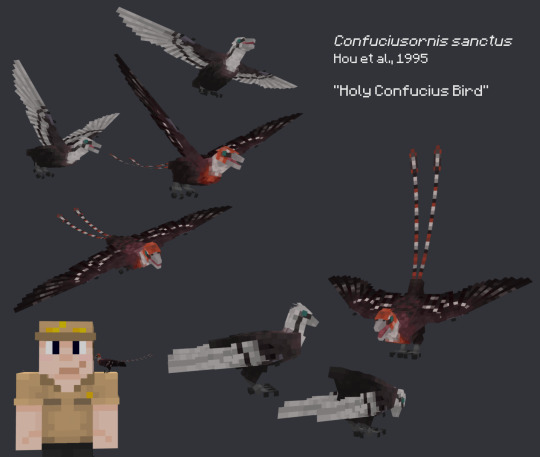
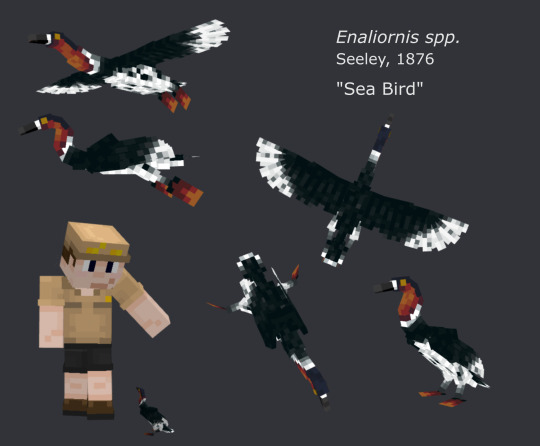
Confuciusornis
Known from Yixian and the overlying Jiufotang Formation of China, this animal has been found in great abundance, numbering hundreds of specimens. Like many modern birds, Confuciusornis was likely sexually dimorphic, with distinct male and female forms. However, the exact nature of this dimorphism has long been controversial, with the big question being whether the tail streamers, known from only a fraction of preserved specimens, were present in both sexes. Fortunately, a 2024 study based on nearly 200 specimens found a statistically significant correlation between the presence of tail feathers, total body mass, and limb proportions, supporting the conclusion that the tailed form most likely represents the male sex. Also like modern birds, Confuciusornis completely lacked teeth, though this appears to have been a convergent innovation, as teeth were still present in several lineages closer to the Neoaves.
Enaliornis
Enaliornis is a genus of primitive Hesperornithiformes that lived from the Albian to Cenomanian in what was then the Tethys Sea. Despite being known from numerous individuals and three separate species, it is incredibly fragmentary, and any reconstruction is largely an exercise in speculation. It is unknown whether it was flightless like more derived Hesperornithiformes, as the forelimbs are not preserved. Like its later cousins, Enaliornis was a specialized foot-propelled diver, though it was likely still capable of upright terrestrial locomotion.

Check out the rest of our recent work on the Prehistoric Nature discord server!

#minecraft#paleontology#prehistoric nature#modded minecraft#blockbench#palaeoblr#confuciusornis#enaliornis
473 notes
·
View notes
Text
Rough timeline of the discovery of genes and DNA
(mostly condensed from the first half of S. Mukherjee, The Gene: An Intimate History, 2016, and this 1974 paper)
1857-1864: Gregor Mendel experiments with breeding peas at the monastery of Brno. The results show that information about flower color, pod shape etc. is transmitted in discrete blocks that do not mix, and can persist unexpressed in a generation to manifest again in the next.
1865-1866: Mendel's results are published in a minor journal and effectively forgotten for 35 years. He corresponds with physiologist Carl von Nägeli, who dismisses them as "only empirical" (???).
1868: Unaware of Mendel's work, Darwin proposes pangenesis as mechanism of heredity: every body part produces "gemmules" that carry hereditary information and merge to form gametes. This does not explain how new traits aren't immediately diluted out of existence, or why acquired changes aren't inheritable.
1869: Friedrich Miescher extracts a mysterious substance from pus on used bandages and salmon sperm. He calls it nuclein (later: chromatin), as it seems to be concentrated in cell nuclei.
1878: Albrecht Kossel separates nuclein into protein and a non-protein component, which he calls nucleic acid, and breaks it down in five nucleotides.
1882: Darwin dies, bothered -- among other things -- by the lack of a plausible mechanism to transmit new variation. Legend has it that Mendel's paper lay on a bookshelf of his study, unread.
1883: August Weissmann, noting that mice with cut tails always give birth to fully-tailed mice, theorizes that hereditary information is contained in a "germplasm" fully isolated from the rest of the body, contra pangenesis. At each generation, only germplasm is transmitted, and gives separate rise to a somatic line, i.e. the body, which isn't.
ca. 1890: Studying sea urchin embryos in Naples, Theodor Boveri and Wilhelm von Waldeyer-Hartz notice large coiled masses of nuclein inside cell nuclei which can be dyed blue with aniline. They call them chromosomes, literally "colorful bodies". Simultaneously, Walter Sutton discovers chromosomes in grasshopper sperm.
1897: Hugo de Vries, after collecting hundreds of "monstrous" plant varieties near Amsterdam, realizes (also unaware of Mendel's work) that each trait is due to a single discrete particle of information, never mixing with the others, which he calls pangene in homage to Darwin. He also notices the appearance of completely new variants, which he calls mutants. In the same year, Carl Correns -- a former student of Nägeli, who had completely neglected to mention Mendel's work -- reproduces it exactly in Tubingen with pea and maize plants.
1900: Having finally found out about Mendel's publication, De Vries rushes to publish his model before he can be accused of plagiarism, which happens anyway. Correns does the same. Erich von Tschermak-Seysenegg also independently recreates Mendel's results with pea plants in Vienna. Come on, guys, this is embarassing.
1902: Boveri and Sutton independently propose that hereditary information is carried by chromosomes. Supporters of this hypothesis generally hold that information is carried by proteins, with the simpler nucleic acids (only 5 nucleotides vs. 20 aminoacids) serving as scaffold.
1905: William Bateson coins the word genetics to describe the field growing mostly from De Vries' work. He realizes it should be possible to deliberately select organisms for specific individual genes. Meanwhile, Boveri's student Nettie Stevens discovers in mealworms a strangely small chromosome that is found only in males -- chromosome Y. This is the first direct evidence that chromosomes do, in fact, carry genetic information.
1905-1908: Thomas Hunt Morgan and his students breed and cross thousands of fruit flies in a lab in New York. Contra Mendel, they notice that traits are not passed down in a completely independent way: for example, male sex and white eyes usually manifest together. This suggests that their information particles are attached to each other, so that the physically-closest traits are more likely (but not guaranteed!) to be transmitted together.
1909: Phoebus Levene and his coworkers break down nucleic acids by hydrolysis into sugars, phosphate, and nucleobases. They assume that nucleobases must repeat along a chain in a repetitive sequence. In a treatise on heredity, Wilhelm Johannsen shortens "pangene" to gene. It's a purely theoretical construct, with no known material basis.
1911: Using Morgan's data on trait linkage, his student Alfred Sturtevant draws the first genetic map, locating several genes along a fruit fly chromosome. Genetic information now has a physical basis, although not yet a mechanism of transmission.
1918: Statistician Ronald Fisher proposes that traits appearing in continuous gradients, such as height, can still be explained by discrete genes if multiple genes contribute to a single trait, resolving an apparent contradiction. (Six genes for height, for example, are enough to produce the smooth bell curve noticed half a century earlier by Francis Galton.)
ca. 1920: Bacteriologist Frederick Griffith is studying two forms of pneumococcus, a "smooth" strain that produces deadly pneumonia in mice (and people) and a "rough" strain that is easily dispatched by immunity. He finds out that if live "rough" pneumococci are mixed with "smooth" ones killed by heat, the "rough" can somehow acquire the deadly "smooth" coating from the dead.
1926: Hermann Muller, another student of Morgan, finds out he can produce arbitrary amounts of new mutant flies by exposing their parents to X-rays.
1928: Griffith describes the acquired "transformation" of bacteria in an extremely obscure journal.
1929: Levene identifies the sugars in "yeast nucleic acid" and "thymus nucleic acid" as ribose and deoxyribose, respectively. The two will henceforth be known as ribonucleic acid (RNA) and deoxyribonucleic acid (DNA).
ca. 1930: Theodosius Dobzhansky, who also had worked with Morgan, discovers in wild-caught fruit flies variations of wing size, eye structure etc. that are produced by genes arranged in different orders on the chromosome. This rearrangement is the first physical mechanism for mutation discovered.
1940: Oswald Avery repeats Griffith's experiments with pneumococci, looking for the "transforming principle". Filtering away the remains of the cell wall, dissolving lipids in alcohol, destroying proteins with heat and chloroform does not stop the transformation. A DNA-degrading enzyme, however, does. Therefore, it is DNA that carries genetic information.
1943: By mixing flies with different gene orders and raising the mixed populations at different temperatures, Dobzhansky shows that a particular gene order can respond to natural selection, increasing or decresing in frequency.
1944: Avery publishes his results on transforming DNA. Physicist Erwin Schrödinger writes a treatise (What Is Life?) in which he states, on purely theoretical ground, that genetic information must be carried by an "aperiodic crystal", stable enough to be transmitted, but with a sequence of sub-parts that never repeat.
1950: In Cambridge, Maurice Wilkins starts using X-ray diffraction to try and make a picture of the atomic structure of dried DNA (as Linus Pauling and Robert Corey had done earlier with proteins). He is later joined by Rosalind Franklin, who finds a way to make higher-quality pictures by keeping DNA in its hydrated state. By hydrolyzing DNA, Erwin Chargaff notes that the nucleobases A and T are always present in exactly the same amount, as if they were paired, and so are C and G -- but A/T and C/G can be different amounts.
1951: Pauling publishes a paper on the alpha-helix structure of proteins. Having attended talks by Wilkins and Franklin, James Watson and Francis Crick attempt to build a physical model of DNA, a triple helix with internal phosphate, but Franklin notes it's too unstable to survive.
1952: Alfred Hershey and Martha Chase mark the protein envelope of phage viruses with radioactive sulfur, and their DNA with radioactive phosphorus. The phosphorus, but not the sulfur, is transmitted to host bacteria and to the new generation of phages. This indicates that DNA is not just exchanged as "transforming principle", but passed down through generations.
1953: Pauling and Corey also propose a structure of DNA, but they make the same mistake as Watson and Crick. These receive from Wilkins an especially high-quality photo (taken in 1952 by either Franklin or her student Ray Gosling). Combining this picture with Chargaff's measurements, they conclude that DNA must be a double helix, with a sugar-phosphate chain outside, and nucleobases meeting in pairs on the inside (A with T, C with G). The complementary sequences of bases give a clear mechanism for the storage and replication of genetic information.
1950s: Jacques Monod and François Jacob grow the bacterium Escherichia coli alternately on glucose and lactose. While its DNA never changes, the RNA produced changes in step with the production of glucose-digesting and lactose-digesting enzymes. So DNA is not directly affected, but different sequences are copied onto RNA depending on need.
1958: Arthur Kornberg isolates DNA polymerase, the enzyme that builds new DNA strands in the correct sequence. By inserting into DNA a heavier isotope of nitrogen, Matthew Meselson and Franklin Stahl show that each strand remains intact, separating during replication and then serving as template for a new one.
1960: Sydney Brenner and Jacob purify messenger RNA from bacterial cells. This seems to copy the sequence of a single gene and carry it to ribosomes, where proteins are built. RNA must encode the sequence of aminoacids of a protein, presumably in sets of 3 nucleotides (the smallest that can specify 20 aminoacids).
1961-1966: Multiple labs working in parallel (Marshall Nirenberg-Heinrich Matthaei-Philip Leder, Har Khorana, Severo Ochoa) map every possible triplet of nucleotides to a corresponding aminoacid. Synthetic RNA is inserted into isolated bacterial ribosomes, and aminoacids are marked one at a time with radioactive carbon to check the sequence of the resulting proteins.
1970: Paul Berg and David Jackson manage to fuse DNA from two viruses into a single sequence ("recombinant DNA") using DNA-cutting enzymes extracted from bacteria.
1972-1973: Janet Mertz joins Berg and Jackson, and proposes inserting the recombinant DNA into the genome of E. coli, exploiting the bacterium for mass production. Herb Boyer and Stanley Cohen perform a similar experiment merging bacterial DNA, and linking it to an antibiotic-resistance gene so that the recombinant bacteria can be easily isolated.
1975-1977: Frederick Sanger isolates template strands of DNA to build new ones with DNA polymerase, but uses altered and marked nucleobases that stop polymerization. By doing so, then segregating the shortened sequences by length and recognizing their final base with fluorescence, it's possible to read the exact sequence of bases on a DNA strand.
350 notes
·
View notes
Text

Physicist Nassim Haramein’s Prediction that the Universe is Rotating Receives a Second Strong Observational Confirmation
by Dr. William Brown, International Space Federation (7th of March, 2025)
In this fascinating 2020 study, researchers observed hundreds of galaxies spinning in synchronized patterns across 20 million light years—a phenomenon deemed "impossible" under standard cosmological models. The observed coherence implies that all of the galaxies are embedded in a large-scale structure that is rotating counter-clockwise. This synchronization should not be there according to the currently accepted cosmological model (the lambda cold dark matter or ΛCDM model).
While conventional physics still struggles with this discovery, Haramein's unified physics theory had already predicted it by demonstrating that mass-energy creates both curvature and torque in spacetime. Because of the ubiquitous nature of spin, which Haramein saw emerging within the mathematics, it led him to predict that we will observe spin across scale, including the universe itself!
Galaxies experiencing a uniform field of torque within a rotating universe will have non-random alignments, just as was observed.
The International Space Federation continues advancing research that challenges traditional cosmological principles to develop a more complete understanding of our dynamic universe.
READ THE FULL ARTICLE
230 notes
·
View notes
Note
Q: how do you draw torsos and legs? Some people say the hands are more difficult but for me it's those things, what tips would you give for those?
I also struggle with legs, way more than I ever struggled with hands. But, every problem has a solution. In this case: skeletons and naked people.
You can trace directly off of real life bodies, but a better practice is to draw your best copy of what you see, making your measuring and line confidence stronger💪
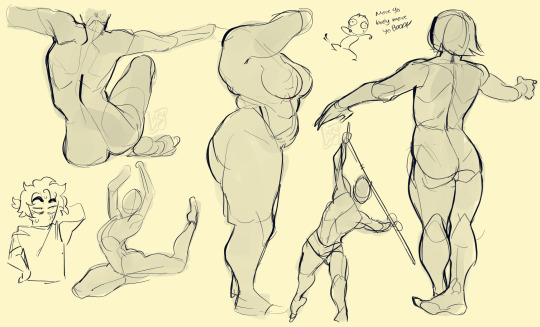
Yeah muscle anatomy is cool, but that’s a factor AFTER learning basic skeleton structuring. Having a 3D model of a skeleton that you can manipulate helps with figuring out how the skeleton moves with muscles, but you can typically see someone’s skeleton straight through their body depending on their weight and position. Below, you can see my simplified version of what I think his skeleton is doing. You need to understand how to build a strong base to create a proper body over it.
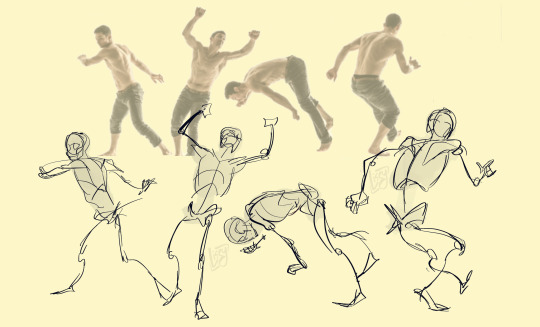
With enough studying of how the skeleton manipulates through the muscles, you can add your own skeleton to your drawing. Knowing each layer of biological anatomy, not just simple limb by limb drawing anatomy, brings much more weight and mass to your characters.
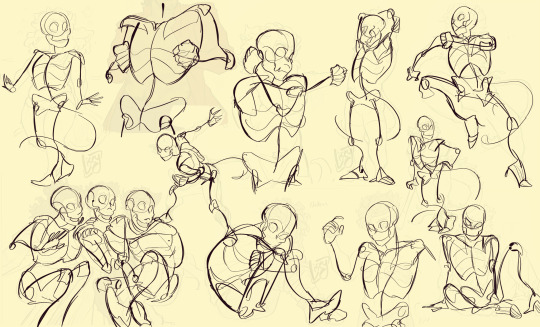
Lots of simple studies to figure out how the bone fits into the muscle so that you don’t have any limbs anatomically clipping over eachother and breaking form
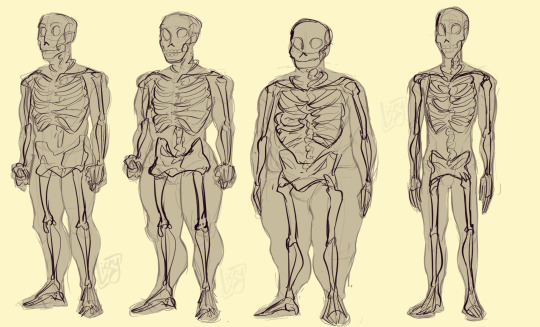
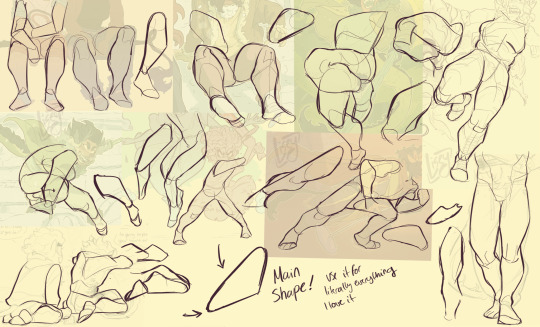
For muscles, first off, just draw lots of naked people, second, use this lemon slice shape to show the weight of flesh, along with the tension of movement along the straight line of the shape. Watch all of this dudes video but specifically this one to understand more
999 notes
·
View notes
Note
You should totally do like a how to draw Konig tutorial for one of ur daily sketches
Chibi or not
But u should totally do it
I neeeeeeeeed ur process
-🦥
notes below the cut - additional notes can be found in this post where I give art tips from my experience
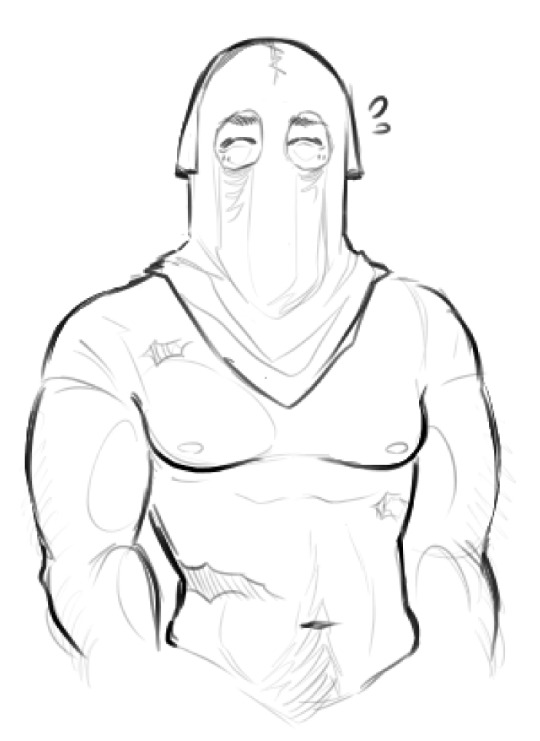
daily König sketch with bonus content♥️‼️post is a little late but it’s due to the info dump below haha, anyways, he’s a little nervous

hi!! thanks for requesting a little “my process” thing - super happy to do one<3
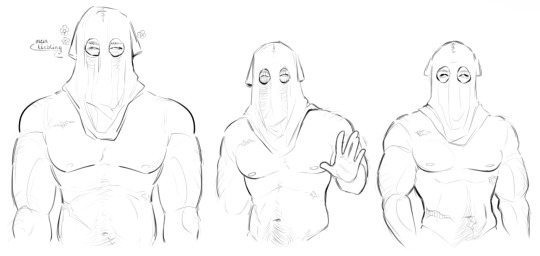
I’ll be using these pieces of him that I’ve done to go over my notes - this is just how I go about drawing him. I’d definitely recommend also going through this post linked above too for additional info because a lot of it carries over!
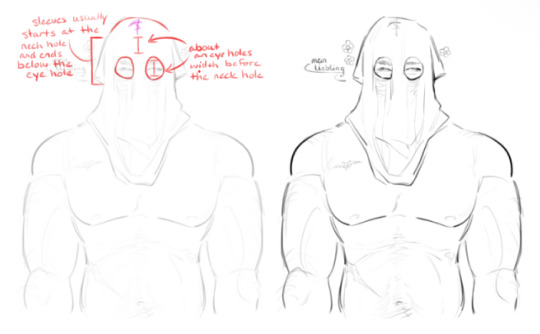
I think the most important thing for me when drawing König is spacing out his hood ratios. I always start out by just drawing where his eyes and eyebrows are, then I draw the cut-outs around them. after that, I start the stitched neckline - that’s usually an eye hole’s width above his actual eyes, it gives a good allusion to where his forehead would be
they aren’t hard and fast rules I follow, more like a silent guideline that can be meddled with depending on the drawing. I usually follow them because, to me, it looks the best with how I draw him. it’s flexible - same with the sleeves, sometimes they end below his eye cut-outs, sometimes I cut them short and they’re higher
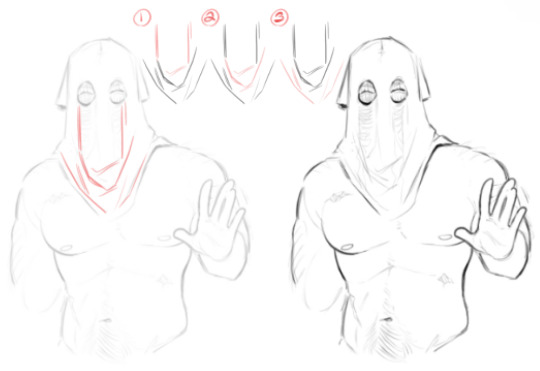
I thought I’d do a step-by-step for the hood folds because just info dumping all at once sounded confusing in my head
I start by just drawing lines down from the corners of his eye cut-outs, then I loosely draw a slanted line to show some bunching of the fabric. the slanted line is usually around where his collarbone would be
best way I can describe figure 2 is drawing folds in a ‘U’ shape. the fabric is falling from his head and ‘pooling’. the ‘U’ shape adds a little depth
miscellaneous little folds around the hem. they follow the way his hood rests, slanting downwards towards the center
if anything, just study how fabric falls and bunches up! a lot of drawing is looking at reference material to figure the ‘why’s and ‘what’s - “why do the folds bunch in certain areas?”, “why is fabric gathering in that area”, “what’s causing the fabric to move like that”, etc
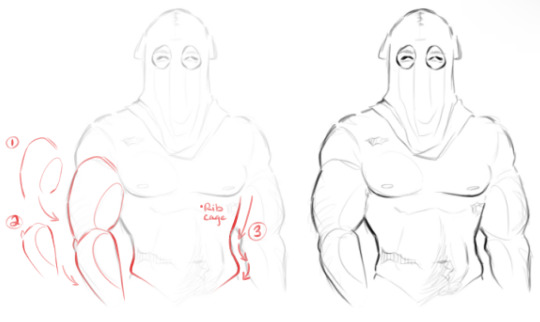
lastly is his body, and as we know, I’m allergic to drawing clothing (read “lazy”). I actually really recommend looking at the post I linked above for this because, in the last figure, I show the Pinterest reference of the man who inspired my König’s body shape (and went into depth on using references)
for arms, in figure 1 and 2, you’ll see me draw an oval inside the bicep and forearm - those are just to add the allusion to muscle mass. if I don’t draw those ovals, to me, it looks a little flat. in figure 3 I go over his waistline because of course I do
I always account for a prominent rib cage line because I personally like drawing a more pronounced rib cage in general. after the ribcage, there’s a slight indent at the waist before it flares back out - that ‘flare out’ is the line for the Adonis belt. again, just personal preference, but I enjoy making the curves a little dramatic so they’re more pronounced and visually appealing to me


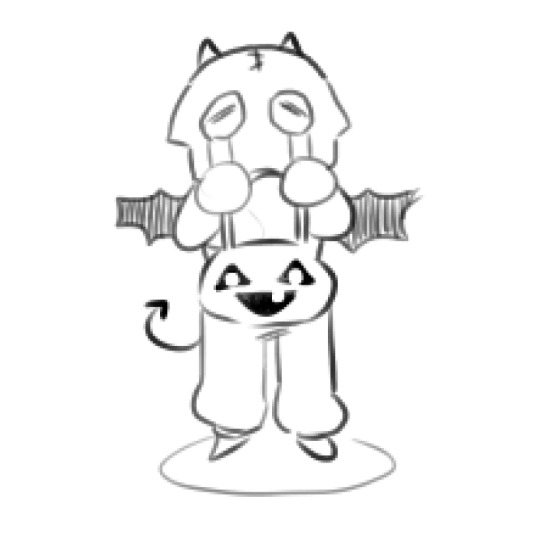
I don’t know how helpful that was but I hope I got some information across - uuh, even though I don’t draw his tactical gear and uniform that often the advice I can give is to just look at his model haha. the only gear that gives me a headache is his helmet, but even then I just bs my way through it
for chibi König I just shrink all his proportions and draw a stupid little t-shirt for his head<3 he doesn’t need to think, he’s just a cute little fella. I draw chibi König the way I would draw a puppy, make him look cute without a thought behind those eyes
for additional reference material here’s the link for my Pinterest - I have an absurd amount of reference material for you to browse through
hopefully this was slightly helpful?? I don’t know, as long as you get something out of this I’m happy
228 notes
·
View notes
Text
The Best News of Last Week
🌍🌡️ - Climate Prophecy: The Forecast Is 100% Chance of 'Cool'
1. No cases of cancer caused by HPV in Norwegian 25-year olds, the first cohort to be mass vaccinated for HPV

Last year there were zero cases of cervical cancer in the population that was vaccinated in 2009 against the HPV virus, which can cause the cancer in women. The HPV virus is extremely common, basically everyone comes into contact with one version or another of the virus in their lifetime.
The vaccine was given to girls only out of an abundance of caution, they were the most likely to contract cancer from the viruses, and because there was limited supply.
2. ‘Every square inch is covered in life’: the ageing oil rigs that became marine oases

Built decades ago, California’s offshore oil platforms are home to a huge diversity of marine life. According to a 2014 study, the rigs were some of the most “productive” ocean habitats in the world, a term that refers to biomass – or number of fish and other creatures and how much space they take up – per unit area.
3. Vaccinations may have prevented almost 20 million COVID-19 deaths worldwide

Vaccinations estimated to have averted 19.8 million COVID-19 deaths worldwide in their first year, according to the latest Imperial modelling study.
In the first year of the vaccination programme, 19.8 million out of a potential 31.4 million COVID-19 deaths were prevented worldwide according to estimates based on excess deaths from 185 countries and territories.
4. Global climate policy forecast predicts ‘well below 2°C’ Paris Agreement climate goals will be met

They report only a 10% probability we exceed 2°C by 2050. Temperatures are expected to peak between 1.7°C and 1.8°C, which is consistent with the “well below 2°C” objective of the Paris Agreement in Art. 2.1c.
5. Young driver fatality rates have fallen sharply in the US, helped by education, technology

Crash and fatality rates among drivers under 21 have fallen dramatically in the U.S. during the past 20 years.
Using data from 2002-2021, the report says that fatal crashes involving a young driver fell by 38%, while deaths of young drivers dropped even more, by about 45%.
6. A Virginia woman was feeling sad. Her doctor prescribed her a cat.
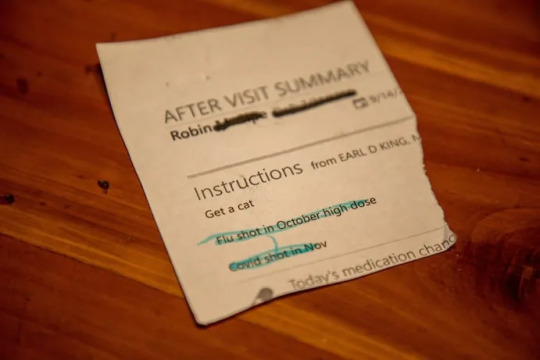
7. Remote workers report saving $5,000 to $10,000 a year

What value would American workers place on the privilege to work from home?
In a 2022 survey by FlexJobs, 45% of remote workers reported saving at least $5,000 a year. One in 5 reported saving $10,000 a year. The savings average out to about $6,000 a year. The poll reached 4,000 workers in July and August of last year.
Three years into the remote-work revolution, research increasingly suggests that telework is a commodity, a job descriptor worth thousands of dollars in potential savings and improved quality of life.
---
That's it for this week :)
This newsletter will always be free. If you liked this post you can support me with a small kofi donation here:
Buy me a coffee ❤️
Also don’t forget to reblog this post with your friends.
1K notes
·
View notes
Text
Seawater will infiltrate underground freshwater supplies in about three of every four coastal areas around the world by the year 2100, according to a recent study led by researchers at NASA's Jet Propulsion Laboratory in Southern California. In addition to making water in some coastal aquifers undrinkable and unusable for irrigation, these changes can harm ecosystems and corrode infrastructure. Called saltwater intrusion, the phenomenon happens below coastlines, where two masses of water naturally hold each other at bay. Rainfall on land replenishes, or recharges, fresh water in coastal aquifers (underground rock and soil that hold water), which tends to flow below ground toward the ocean.
Continue Reading.
224 notes
·
View notes
Note
Do you have any advice or tips with drawing? Any will help me I hope you have a good day
I think it would help to analyze references in the beginning, to build up a visual library

I was taught at university to first see the general masses, the silhouette. This method is called “general to particular”. And due to this stage, it is much easier for you to perceive the image, the composition as a whole, rather than running straight away to draw eyes, hands or other details
Starting with a silhouette also helps to create character designs in the future ✍️

Then you can already outline the construction, the middle forms. Again without small details, but you can leave a hint of them with the help of auxiliary lines.
I don't really work with tone so much at this stage, I just showed you how you can even use it to outline light shading (also common masses)

It also helps to do chopped, rough construction with a couple lines. I would generally advise practicing confidence in hand movements and understanding of general shapes. How clean your sketches are will help you navigate more easily in the future. And general shapes affect mostly how you can stylize body parts, how you understand their construction based on simple geometric shapes. It's a mistake to think that working with a reference is a one-to-one repetition of the original image. Artists use some kind of distortion of proportions, changing details or a little pose based on experience to make a character or work more dynamic

And then you can go into detail 💅
--------
I mean, already as in my experience I say that repeating or re-learning the base, which is lines, shapes, improves your drawing skill.
Because the faster you get through sketches, the faster you can move on to other stages of drawing, and still make fewer fundamental mistakes
And if you want to study anatomy, plastic anatomy would be the way to go for artists. I worked up my anatomy by looking at books and tutorials from the authors belowotome ↓


The authors of this book post tutorials using 3D models on Pinterest and ArtStation
I realized for myself that I am not a classical artist, that learning from the works and books of old academic masters is boring and not interesting to me. My approach is to analyze not only nature, but also 3d models. Analysis of 3d models helps with understanding of shapes in space, light shading and “what are occlusions” for game rendering ↓

Like this :D. But this is already relatively my old work and now I can do better, but I'm lazy
I hope my tips were helpful 🗣️
134 notes
·
View notes